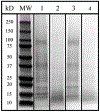Cultivation and aerosolization of Stachybotrys chartarum for modeling pulmonary inhalation exposure
- PMID: 31874574
- PMCID: PMC7021356
- DOI: 10.1080/08958378.2019.1705939
Cultivation and aerosolization of Stachybotrys chartarum for modeling pulmonary inhalation exposure
Abstract
Objective:Stachybotrys chartarum is a hydrophilic fungal species commonly found as a contaminant in water-damaged building materials. Although several studies have suggested that S. chartarum exposure elicits a variety of adverse health effects, the ability to characterize the pulmonary immune responses to exposure is limited by delivery methods that do not replicate environmental exposure. This study aimed to develop a method of S. chartarum aerosolization to better model inhalation exposures. Materials and methods: An acoustical generator system (AGS) was previously developed and utilized to aerosolize and deliver fungal spores to mice housed in a multi-animal nose-only exposure chamber. In this study, methods for cultivating, heat-inactivating, and aerosolizing two macrocyclic trichothecene-producing strains of S. chartartum using the AGS are described. Results and discussion: In addition to conidia, acoustical generation of one strain of S. chartarum resulted in the aerosolization of fungal fragments (<2 µm aerodynamic diameter) derived from conidia, phialides, and hyphae that initially comprised 50% of the total fungal particle count but was reduced to less than 10% over the duration of aerosolization. Acoustical generation of heat-inactivated S. chartarum did not result in a similar level of fragmentation. Delivery of dry, unextracted S. chartarum using these aerosolization methods resulted in pulmonary inflammation and immune cell infiltration in mice inhaling viable, but not heat-inactivated S. chartarum. Conclusions: These methods of S. chartarum growth and aerosolization allow for the delivery of fungal bioaerosols to rodents that may better simulate natural exposure within water-damaged indoor environments.
Keywords: Fungi; acoustical generator; fungal aerosolization; fungal exposure; fungal fragments; inhalation exposure.
Conflict of interest statement
Disclosure of interest
The authors declare no conflict of interest.
Figures










References
-
- Adhikari A, Reponen T, Rylander R. 2013. Airborne fungal cell fragments in homes in relation to total fungal biomass. Indoor Air. 23(2):142–147. - PubMed
-
- Andersen B, Nielsen KF, Jarvis BB. 2002. Characterization of Stachybotrys from water-damaged buildings based on morphology, growth, and metabolite production. Mycologia. 94(3):392–403. - PubMed
-
- Andersen B, Nielsen KF, Thrane U, Szaro T, Taylor JW, Jarvis BB. 2003. Molecular and phenotypic descriptions of Stachybotrys chlorohalonata sp. nov. and two chemotypes of Stachybotrys chartarum found in water-damaged buildings. Mycologia. 95(6):1227–1238. - PubMed
Publication types
MeSH terms
Substances
Grants and funding
LinkOut - more resources
Full Text Sources
